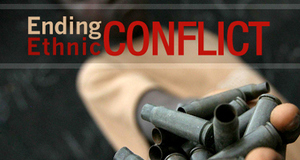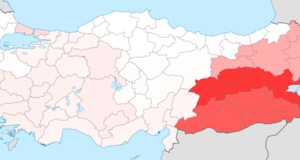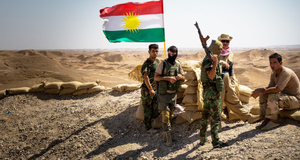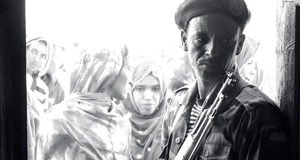Comparing the Roots of Conflict in Europe, the Middle East, and Africa
By
2016, Vol. 8 No. 04 | pg. 2/2 | « DiscussionWhen looking at the correlation of site conflict, we had to consider certain factors. First, site conflict can never be considered by itself. We defined site conflict as control over an area that is seen as strategically important by both groups. This strategic importance usually involved other factors that we considered, such as religion, water, and oil. Therefore, when looking at correlation between site conflict and these other factors, one should remember that these natural correlations may help explain geographic and historical importance of sites in each region. Additionally, we found another interesting phenomenon. When one usually thinks of an instance of ethnic conflict or land conflict, he or she usually thinks of a highly publicized and traumatic event that shocked the world. Examples of this would be the genocide in Rwanda for ethnic conflict and the Second World War for land and ethnic conflict. However, from what we found, these cases are not representative of the continents as a whole. Generally speaking, from 1900 there were no land conflicts that took place with actors in only Europe (World War I and II are not considered because they are intercontinental conflicts). When looking at Africa, we found that identity conflicts are surprisingly low. This is important, given what we found in our literature review. Our data goes against the scholarly argument, and thus has the potential to remove misconceptions regarding regarding the causes of conflict. Additionally, our discovery of language as a contributory factor for most conflicts is highly significant. We hypothesize this is because it is an exasperant of conflict in general. When two countries have two different languages (such as Mexico and the United States), this usually means that they share distinct cultures and histories. Differences can create more tensions in areas of conflict (such as common borders and conflict over resources such as oil and water). Differing languages and cultures can also cause miscommunications between leaders. In part, this might be because a lack of understanding of cultural norms can cause tension where it would not usually exist.For example, something as simple determining what negotiations and what peace are must be established when countries speak two different languages31. This sort of miscommunication is indicative of the challenges countries face in negotiations. This can make negotiations difficult, especially when the countries have had a long history of conflict. Before discussing our results, we must examine the possible issues in our project. First, all of the conflicts that we recorded had a combined 1,000 deaths. We chose 1,000 deaths as the standard in order to maintain the feasibility of our project with the limited amount of databases available to us. This limitation most certainly caused issues, the most blatant being that all battles under 1,000 deaths were ignored by our study, which could have skewed our results. Second, no intercontinental conflicts were recorded in order to limit outside factors that might distort our results. However, this may also have skewed our results. For example, in Africa, decision eliminates all conflict between colonial governments and the African independence movements, which constituted the majority of conflicts in Africa from 1900 to today. While this precaution helped ensure that there were no distorting factors in our study, it does also mean that we lost a large amount of potentially valuable information regarding these conflicts. Additionally, determining the exact causes of conflict was difficult. For example, the official explanation given for the 2003 Invasion of Iraq was because government’s suspected Saddam Hussein possessed weapons of mass destruction (WMDs). However, many have speculated that the invasion was actually carried out to secure oil in the country. If we had coded this example, it would have been very challenging to determine what the real cause of the conflict was. Additionally, as previously mentioned, there was no way for us to prioritize which factor caused more conflict than others. This would have considerably helped our study, but it was not feasible with the dummy variables used in our study. Lastly, and most importantly, we could not establish causation with the research methods we used. We used Pearson’s R, which provided us the most accurate data we could have as a result of the dummy variables used. But this could establish causation. Thus, while we can examine correlation trends in our study, this in no way means causation. In order to improve our study as a whole, a broad increase in the breadth and depth of our data would help increase the reliability and accuracy of our project. However, this sort of increase is beyond the scope of this project. Middle EastWhen considering our results in the Middle East, several of our results were of great interest. First, the correlation we found between oil and maritime conflict can be explained as a result of the importance of the oil trade. In the Middle East, maintaining maritime security and maintaining a port is of the utmost importance if the country is an oil exporter. Most states in the Middle East are oil dependent countries, or could be classified as rentier states. Rentier states are countries that rely on a major resource, such as oil, which does not require high levels of productivity to make massive profits32. Therefore, if an enemy of an oil dependent state can cut off the most profitable and widely used mode of transport of oil, the economy of the oil dependent state can grind to a halt. This was seen during the Iran-Iraq War, Iraq attacked all ships attempting to trade with Iran as a way to halt their economy33. Therefore, states will do whatever they can to maintain their oil trade, even if this means conflict. Another correlation of particular significance is the correlation of religion with linguistic conflict, border conflict, ethnicity conflict, and site conflict. This is also an explainable phenomenon. Religion, especially in the Middle East, works closely with identity. For example, Arabic and Islam are closely tied, as is Hebrew and Judaism. The same goes for the Arab ethnicity and Islam, along with the Jewish ethnicity and Judaism. Therefore, it is understandable why there is a correlation between these factors. In regards to site conflict, this is explainable because of the Holy Sites that appear in the Middle East. This occurs because three major world religion, Judaism, Islam, and Christianity all share this area as a common Holy Land. From 1900 to before the Second World War, most of the conflict was over the Islamic city of Mecca34. After the Second World War, Israel was created, which caused much of the site conflict to be about Jerusalem. In regards to border conflict, much of the conflict comes from the various wars surrounding Israel. In our study, since the creation of Israel, 78% of state vs. state border conflicts involved Israel. This and the religious correlations prove how significant the Arab Israeli conflict to the Middle East, contrary to the argument made by Bernard Lewis in our Literature Review. In regards to water conflict, we find that conflict over water will be significant in areas of little oil and water. Countries not having water conflict with abundant water is self-explanatory, however the significance of oil must be explained. With a massive income coming from oil, countries can afford to spend money desalination (removing salt) from seawater or can afford to import freshwater from other countries. AfricaThe reasons for correlation in Africa is less evident than those in the Middle East. Our results showed an overall lack of identity conflict during our study, which can be explained by Smith (2000), called “The Impact of Political Liberalisation and Democratisation on Ethnic Conflict in Africa: An Empirical Test of Common Assumptions”[35]. In this, Smith tests to see if there is an increase in ethnic conflict following democratization in Africa as a result of the Third Wave of Democracy36. This is applicable to our study because of our removal of colonial struggles in Africa. This means that most of our African conflicts occur after 1970, which is around when the Third Wave of Democracy began. Thus, this essay is a good reference to explain our study. The argument for this claimed that, as a result of greater democratic freedoms, ethnic groups would use this to their advantage through political manipulation and ethnic based political parties37. However, Smith found that when there is increasing amounts of democratic freedom, ethnic conflict actually decreases38. This is because that, through increasing freedoms, Africans are allowed to express their ethnicity in productive ways39. We believe that our study has observed this phenomenon. The extreme negative effect of political conflict and border conflict may be the result of two factors. First, it may be the result of the border drawing done by the Europeans during colonization, which did not take into account the ethnic groups in the area. Thus, it is possible that the conflict post-colonization is more internal than external. The other and more probable answer is that we did not capture the effects of border conflict properly because of the limitations we placed on our study. For example, there were several border conflicts, such as the Eritrea-Djibouti Border Conflict of 200840, that was not captured by our study because the amount of deaths was under 1,000. Generally speaking, there were other factors that greatly distorted our study. First, the large number of languages in Africa, which numbers over 3,00041. Thus, these large number of languages could make it appear that there are more linguistic conflicts than there were in reality. Additionally, in Africa, people will speak the colonial language and one or more indigenous languages42. Therefore, it can be very challenging to determine linguistic conflicts with so many other factors. Site conflict’s correlation with water conflict and vice versa may also be indicative of the shortage of freshwater that is plaguing over one billion Africans today43. EuropeEurope, while having more distinct reasons for correlation than Africa, are still not as evident as the Middle East. First, there was a correlation between water conflict and site conflict. As previously seen in Africa, this could be the result of a great water shortage in Europe, but there is no evidence to support this. The more likely answer is that this is the result of controlling ports for trade. During the first half of the 20th century, colonialism was a powerful force in Europe, with a great reliance on the resources from their colonies to fuel production in the home countries. Additionally, trade in general helped countries finance their economy, so losing a port would greatly harm their economy. Thus, conflict over controlling a port is most likely the reason for such a correlation. While we found no cases of religious conflict in Europe, we know this is not the case. There are individual cases (such as conflict in Kosovo in the 2000s44) that do not fit the parameters of our study because of the number of deaths in the conflict does not reach 1,000. Thus, we are unable to see the correlations in regards to religion. Linguistic conflict and ethnic conflict most likely correlate as a result of the Cold War. The Cold War in Europe provided Europe with a unique situation. From the period of the Cold War (1945-1989), there were only three intracontinental conflicts in the region (unrest in Hungary, the Greek Civil War, and the Troubles in Ireland). This is significant because it not only greatly limits our data, but the shadow of the Cold War greatly affected Europe after this. Before the Cold War, the majority of the conflicts considered were political or independence struggles, with the majority of them in the Balkans region. This is indicative of the period of time, where even in Europe colonialism was rampant. However, after the Cold War ended, the majority of conflicts were identity conflicts, particularly that of ethnicity. Interestingly enough, most of these also occurred in the Balkans region. We propose that this dramatic change was helped by the end of the Cold War and the dissolve of the Soviet Union. Yugoslavia had various ethnic, linguistic, and religious tensions throughout its existence, but the collapse of the Soviet Union and the Eastern Bloc led to even more severe instability in Yugoslavia45. This ultimately led to the breakup of Yugoslavia and many wars fought between various ethnic and religious groups in the area, many of whom spoke different languages. Thus, as a result of this massive phenomena, we found this correlation between ethnicity and language. ConclusionWhen studying conflicts, there are certain biases that occur that may distort one’s perception of conflict. Specifically, the biases regarding continental conflict are blatant, especially in regards to oil conflict in the Middle East and Africa in regards to ethnic conflict. Our study suggests that not only are these assumptions completely false. this is a result of using very public cases, such as the First Gulf War for oil conflict in the Middle East, as evidence for the entire continent. A more complex view of these areas must be created. Instead of oil being a key contributing factor of conflict, water, whether it be maritime access or freshwater, should instead be considered as a key contributing factor. For Africa, instead of ethnic conflict being considered a chief source of conflict, water access and linguistic differences should instead be considered as a major reason for conflict on the continent. When it comes to Europe, the idea of the continent as a “gold standard” must also be discarded. The lack of conflict was the result of the Cold War, where interstate conflict could escalate into a thermonuclear war. But, before and after the Cold War, inter and intrastate conflicts were prevalent. Generally speaking, linguistic and cultural differences must be more deeply considered when considering negotiations between states. While this is considered between negotiators, the public must also consider this during crises between two countries. If two countries are in conflict, individuals must consider the various linguistic and cultural differences that may appear between them. As a whole, individuals must consider not only continental conflict in a more complex way, but interstate conflict as well. Endnotes1.) Maxwell, John W., and Rafael Reuveny. “Resource Scarcity and Conflict in Developing Countries.” Journal of Peace Research 37.3 (2000): 301–322. 303. 2.) Brunnschweiler, Christa N., and Erwin H. Bulte. “Natural Resources and Violent Conflict: Resource Abundance, Dependence, and the Onset of Civil Wars.” Oxford Economic Papers61.4 (2009): 651–674. Web. 670. 3.) Gurr, Ted Robert. “Peoples Against States: Ethnopolitical Conflict and the Changing World System: 1994 Presidential Address.” International Studies Quarterly 38.3 (1994): 347–377. Web. 348. 4.) Ibid. 348-355. 5.) Haftendorn, Helga. “Water and International Conflict.” Third World Quarterly 21.1 (2000): 51–68. Web. 51. 6.) Ibid. 52. 7.) Ibid. 53. 8.) Cotet, Anca M., and Kevin K. Tsui. “Oil and Conflict: What Does the Cross Country Evidence Really Show?.” American Economic Journal: Macroeconomics 5.1 (2013): 49–80. 51. 9.) Ibid. 49. 10.) Lewis, B. (2008). Conflict in the Middle East. Retrieved from http://www.tandfonline.com/doi/abs/10.1080/00396337108441232 11.) Sørli, Mirjam E., Nils Petter Gleditsch, and Håvard Strand. “Why Is There so Much Conflict in the Middle East?.” The Journal of Conflict Resolution 49.1 (2005): 141–165. Web. 141. 12.) Ibid. 144. 13.) Kliot, N. (1994). Water Resources and Conflict in the Middle East. Retrieved from https://books.google.com/books?hl=en&lr=&id=IRGxvz1B8p8C&oi=fnd&pg=PP1&dq=conflict%2Bin%2Bthe%2Bmiddle%2Beast&ots=kbuS78PEYf&sig=qY_AXvjWVOscPB-PhsCM7UpbvTo#v=onepage&q=conflict%20in%20the%20middle%20east&f=false 14.) Sørli, Mirjam E., Nils Petter Gleditsch, and Håvard Strand. “Why Is There so Much Conflict in the Middle East?.” The Journal of Conflict Resolution 49.1 (2005): 141–165. Web. 156. 15.) Brown, O., & Crawford, A. (2009). Rising temperatures, rising tensions climate change and the risk of violent conflict in the Middle East. Winnipeg, Manitoba, Canada: International Institute for Sustainable Development. 16.) Lesser, I. O., Nardulli, B. R., & Arghavan, L. A. (n.d.). Sources of Conflict in the Greater Middle East. RAND Corporation. Retrieved from https://www.rand.org/content/dam/rand/pubs/monograph_reports/MR897/MR897.chap4.pdf 17.) Ibid. 189. 18.) Huntington, Samuel P.. “The Clash of Civilizations?.” Foreign Affairs 72.3 (1993): 22–49. Web. 253. 19.) Sørli, Mirjam E., Nils Petter Gleditsch, and Håvard Strand. “Why Is There so Much Conflict in the Middle East?.” The Journal of Conflict Resolution 49.1 (2005): 141–165. Web. 156. 20.) Henderson, E. A. (2009). Disturbing the Peace: African Warfare, Political Inversion and the Universality of the Democratic Peace Thesis. British Journal of Political Science, 39, 25-58. 21.) El-Ayouty, Yassin, and I. William. Zartman. The OAU after Twenty Years. New York, NY, U.S.A.: Praeger, 1984. Print. 22.) Boyd, B., Jr. (1979). African Boundary Conflict: An Empirical Study. African Studies Review, 22, 1-14. 23.) Fisher, M. (2013, December 30). 9 questions about South Sudan you were too embarrassed to ask. Retrieved from https://www.washingtonpost.com/news/worldviews/wp/2013/12/30/9-questions-about-south-sudan-you-were-too-embarrassed-to-ask/ 24.) Smith, Zeric Kay. “The Impact of Political Liberalisation and Democratisation on Ethnic Conflict in Africa: An Empirical Test of Common Assumptions.” The Journal of Modern African Studies38.1 (2000): 21–39. 32. 25.) Ibid. 26.) Lesser, I. O., Nardulli, B. R., & Arghavan, L. A. (n.d.). Sources of Conflict in the Greater Middle East. RAND Corporation. 28. 27.) Van Oudenaren, J. (n.d.). Sources of Conflict in Europe and the Former Soviet Union. 239. RAND Corporation. Retrieved from http://www.rand.org/dam/rand/pubs/monograph_reports/MR897/MR897.chap5.pdf 28.) Ibid. 240. 29.) Fox, Jonathan. “Two Civilizations and Ethnic Conflict: Islam and the West.” Journal of Peace Research 38.4 (2001): 459–472. 464. 30.) Ibid. 31.) Cohen, Raymond. “Language and Conflict Resolution: The Limits of English.” International Studies Review 3.1 (2001): 25–51. Web. 27. 32.) Kamrava, M. (2007). "The Middle East Democracy Deficit in Comparative Perspective." Perspectives on Global Development and Technology 6(1): 189-213. 203. 33.) "The Tanker War." The Strauss Center. The University of Texas at Austin, Aug. 2008. Web. 34.) "The Great Arab Revolt." Jordan.gov. N.p., n.d. Web. 11 Dec. 2015. 35.) Smith, Zeric Kay. “The Impact of Political Liberalisation and Democratisation on Ethnic Conflict in Africa: An Empirical Test of Common Assumptions.” The Journal of Modern African Studies 38.1 (2000): 21–39. 36.) Ibid. 24. 37.) Ibid. 22. 38.) Ibid. 32. 39.) Ibid. 22. 40.) "France Backing Djibouti in 'war'" BBC News. BBC, 13 June 2008. Web. 11 Dec. 2015. 41.) Epstein, Edmund L.; Kole, Robert, eds. (1998). The Language of African Literature. Africa World Press. p. ix. 42.) Badejo, B. Rotemi. "Multilinguism in Sub-Saharan Africa." Africa Media Review (1989): n. pag. Web. 43.) "Global Water Shortage: Water Scarcity & The Importance of Water." The Water Project. N.p., n.d. Web. 11 Dec. 2015. 44.) "Cultural Heritage in South-East Europe: Kosovo; Protection and Conservation of Multi-ethnic Heritage in Danger, Mission Report, 26-30 April 2004; n. pag. Unesco Office Venice And Regional Bureau For Science In Europe (Italy). 2004. Web. 45.) "The Breakup of Yugoslavia." Office of the Historian. US Government, n.d. Web. 11 Dec. 2015. TablesSuggested Reading from Inquiries Journal
Inquiries Journal provides undergraduate and graduate students around the world a platform for the wide dissemination of academic work over a range of core disciplines. Representing the work of students from hundreds of institutions around the globe, Inquiries Journal's large database of academic articles is completely free. Learn more | Blog | Submit Latest in Political Science |


















